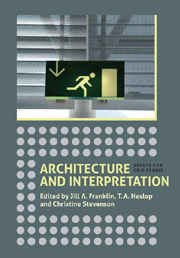Book contents
- Frontmatter
- Contents
- List of Illustrations
- Preface: In Appreciation
- List of contributors
- 1 Introduction
- Incitements to Interpret in Late Antique and Medieval Architecture
- Authors and Intentions
- Architecture beyond Building
- 266 Innovation and Traditionalism in Writings on English Romanesque
- 284 Why Medieval Ireland Failed to Edify
- 306 The Chapel of the Hospital of Saint-Jean at Angers: Acta, Statutes, Architecture and Interpretation
- 315 Sealed Architecture: City Seals, Architecture and Urban Identity in the Northern Netherlands, 1200–1700
- 333 Style and Geography: Struggles for Identification in the Later Nineteenth Century
- 343 The Dome of the Rock: From Medieval Symbol to Modern Propaganda
- 357 Towards a Cultural Geography of Modern Memorials
- 381 Bicycle Sheds Revisited, Or: Why are Houses Interesting?
- Index
343 - The Dome of the Rock: From Medieval Symbol to Modern Propaganda
from Architecture beyond Building
Published online by Cambridge University Press: 05 April 2013
- Frontmatter
- Contents
- List of Illustrations
- Preface: In Appreciation
- List of contributors
- 1 Introduction
- Incitements to Interpret in Late Antique and Medieval Architecture
- Authors and Intentions
- Architecture beyond Building
- 266 Innovation and Traditionalism in Writings on English Romanesque
- 284 Why Medieval Ireland Failed to Edify
- 306 The Chapel of the Hospital of Saint-Jean at Angers: Acta, Statutes, Architecture and Interpretation
- 315 Sealed Architecture: City Seals, Architecture and Urban Identity in the Northern Netherlands, 1200–1700
- 333 Style and Geography: Struggles for Identification in the Later Nineteenth Century
- 343 The Dome of the Rock: From Medieval Symbol to Modern Propaganda
- 357 Towards a Cultural Geography of Modern Memorials
- 381 Bicycle Sheds Revisited, Or: Why are Houses Interesting?
- Index
Summary
EVERYONE knows that there is no such thing as a free lunch. Similarly, if there is one thing that the twentieth century has taught us, it is that it is untrue to say that the camera cannot lie. It lies all the time. Consider the photographs that newspapers keep on file depicting famous people frozen in an expression, gesture or context that is damaging to their image, and that gives a false impression of them. To paraphrase Winston Churchill, that may not be a lie exactly, but it is surely a visual inexactitude.
And monuments no less than people are subject to manipulation, as this paper will explore. That manipulation can be innocent – or not so innocent. A good example of that proposition is the Dome of the Rock, built, as its foundation inscription records, by the Umayyad caliph ‘Abd al-Malik in AH 72/AD 691 and situated in the Haram al-Sharif, the vast precinct which also contains the site of the Temple of Solomon (fig. 1). There is no need to dilate here on its first century of life, a topic that has, perhaps unfairly, dominated the history of scholarship on this building. Instead, this paper will examine aspects of its afterlife – past, present and future – in the particular context of how it has worked as a symbol. After a brief survey of some of the many modern photographs that use it for the purposes of one agenda or another, the paper will discuss – again briefly – how the Dome of the Rock has fared in the Muslim, the Christian and the Jewish past.
- Type
- Chapter
- Information
- Architecture and InterpretationEssays for Eric Fernie, pp. 343 - 356Publisher: Boydell & BrewerPrint publication year: 2012



